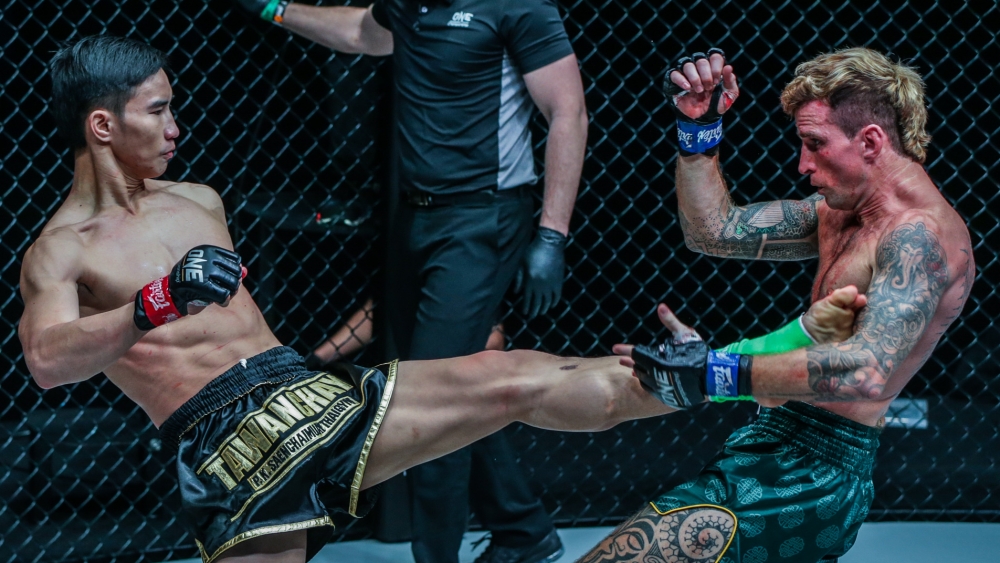In Muay Thai, fighters look for ways to enhance their defensive capabilities and maintain control over their opponents. One such technique that has gained significant recognition is the knee guard. The knee guard is a transitional move executed after delivering a knee strike, where the same-side leg is raised and positioned horizontally across the opponent’s body.
This strategic guard position serves as a powerful defensive tool, offering protection against counterattacks while providing opportunities for follow-up strikes and controlling the flow of the fight.
Importance Of Mastering This Transitional Move
Mastering the knee guard in Muay Thai is important for any fighter looking to excel in the clinch and gain an upper hand in the ring. It not only safeguards against an opponent’s potential retaliation after a knee strike but also serves as a launchpad for offensive maneuvers. By effectively utilizing the knee guard, fighters can neutralize their opponents’ attacks, create openings for strikes, and exert dominance in close-quarters combat.
Understanding The Knee Guard
To grasp the essence of the knee guard in Muay Thai, you need to understand its mechanics and the underlying technique. The knee guard involves raising the same-side leg that executed the knee strike and positioning it horizontally across the opponent’s body. This creates a physical barrier that shields against incoming strikes and controls the opponent’s movement.
The knee guard relies on a combination of balance, stability, and core strength. The supporting leg provides a solid foundation, while the knee acts as the pivotal point for maintaining control. The fighter’s arms can be positioned for added stability, either clasping the opponent’s arms or engaging in a clinch position.
Key Principles And Body Positioning For Effective Execution
Executing the knee guard effectively requires adherence to several key principles and optimal body positioning. Here are some essential considerations:
- Balance And Stability: Maintaining a strong base and stable posture is paramount. Distribute your weight evenly between your legs, engage your core, and keep your upper body upright.
- Active Guarding: Apply pressure with the knee guard by pressing it firmly against your opponent’s body. This actively obstructs their movements and makes it more challenging for them to mount an effective counterattack.
- Counterbalance: To enhance balance and stability, use your non-supporting hand to grasp your opponent’s arm or shoulder, creating a counterbalance against their attempts to disrupt your position.
- Head Positioning: Keep your head upright and aligned with your spine. This helps you maintain awareness of your surroundings and prevents your opponent from gaining advantageous positioning.
- Weight Distribution: Optimize weight distribution between your legs. Too much weight on the front leg can compromise balance, while too much weight on the back leg limits mobility. Find the right balance for quick transitions and effective defense.
By adhering to these principles and maintaining proper body positioning, you can execute the knee guard with precision and maximize its defensive capabilities in the heat of combat.
Differentiating The Knee Guard From Other Guard Positions In Muay Thai
It’s important to note that the knee guard is a distinct guard position in Muay Thai, separate from other commonly used guards such as the traditional high guard or low guard. While the knee guard shares some similarities in terms of its defensive purpose, it specifically capitalizes on the transitional moment after a knee strike, allowing the fighter to seamlessly transition from offense to defense.
Unlike static guards, such as the high guard or low guard, the knee guard is a dynamic position that demands constant adjustments and adaptability. It enables the fighter to maintain control and readiness for further engagement, setting the stage for potential follow-up strikes or defensive maneuvers.
Understanding the unique mechanics, principles, and differentiating factors of the knee guard in Muay Thai lays a solid foundation for mastering this transitional move.
Defensive Advantages Of The Knee Guard
- Protection Against Counterattacks: The knee guard serves as a formidable defensive tool, shielding you from an opponent’s immediate counterattacks following a knee strike. By positioning your leg horizontally across their body, you create a barrier that blocks strikes and disrupts their ability to mount an effective offensive response.
- Control In The Clinch: The knee guard enables you to maintain control in the clinch, a crucial aspect of Muay Thai. By utilizing the knee guard, you can effectively neutralize your opponent’s attempts to gain dominant positioning and limit their ability to execute strikes or initiate grappling techniques.
Offensive Opportunities Presented By The Knee Guard
- Follow-Up Strikes: The knee guard sets the stage for devastating follow-up strikes. By utilizing the knee guard as a transitional position, you can quickly transition from defense to offense and capitalize on your opponent’s compromised position. Strikes such as elbows, punches, or kicks can be seamlessly launched from the knee guard, catching your opponent off guard and inflicting significant damage.
- Sweeps And Throws: The knee guard also provides opportunities for sweeps and throws. By leveraging your stability and control in the knee guard position, you can off-balance your opponent and execute sweeps or throws, effectively taking them down to the canvas and gaining a dominant position.
The knee guard’s versatility in both defense and offense makes it a valuable asset in the arsenal of a Muay Thai practitioner. It not only offers protection and control but also opens up avenues for devastating strikes and grappling techniques.
Conditioning Exercises To Strengthen The Core And Legs For Stability
Plank Variations: Planks help develop core strength, which is essential for maintaining stability in the knee guard. Incorporate standard planks, side planks, and plank variations such as plank leg lifts to challenge your core muscles.
Squats And Lunges: These exercises target the muscles of the legs, including the quadriceps, hamstrings, and glutes. Strong leg muscles provide stability and power in executing the knee guard.
Balance Exercises: Incorporate exercises like single-leg balances or balance board drills to enhance proprioception and improve overall balance, crucial for maintaining control in the knee guard position.
Drills For Developing Quick Transitions Into The Knee Guard
- Strike Combinations: Practice combinations that culminate in a knee, such as jab–cross–knee or hook–uppercut-knee. Focus on fluidly transitioning from a strike to the knee guard position immediately after the strike.
- Mirror Drills: Partner up and take turns practicing knee strikes and transitioning into the knee guard position. Work on speed and precision, aiming to seamlessly flow from strike to guard and vice versa.
- Shadowboxing With Knee Guard Transitions: Incorporate knee guard transitions into your shadowboxing routine. Visualize an opponent’s strikes and practice executing the knee guard as a defensive response.
Partner Training Exercises To Simulate Real Combat Scenarios And Improve Timing
- Clinch Drills: Engage in clinch training with a partner, focusing on utilizing the knee guard as a defensive tool within the clinch. Practice controlling your partner’s movements, maintaining the knee guard position, and countering with strikes or sweeps when opportunities arise.
- Counterattack Drills: Have your partner simulate various strikes and attacks while you practice transitioning into the knee guard position to defend against them. React quickly and effectively, utilizing the knee guard to block and counter with strikes of your own.
Consistent training with these conditioning exercises and drills will help develop the necessary physical attributes, timing, and fluidity required to execute the knee guard effectively in real combat scenarios. By incorporating these training methods into your routine, you’ll enhance your proficiency in the knee guard and elevate your overall performance in Muay Thai.
Application And Strategy
In the realm of real-world application, the knee guard in Muay Thai has been successfully utilized by professional fighters to gain an edge in the heat of battle. By implementing the knee guard effectively, fighters can defend against counterattacks, control the flow of the fight in the clinch, and capitalize on offensive opportunities.
Strategies for integrating the knee guard into one’s overall fighting style involve reading opponents, timing the knee guard, and adapting it to different opponents and fight scenarios. Understanding these strategies and applying them in the ring can significantly enhance a fighter’s performance and ability to dominate their opponents.
Conclusion
Mastering the knee guard in Muay Thai is a valuable asset for any practitioner. By understanding the mechanics and technique, adhering to key principles of balance and stability, and differentiating the knee guard from other guard positions, fighters can unlock their defensive advantages and offensive potential.
Through conditioning exercises, drills for quick transitions, and partner training exercises, practitioners can develop the necessary skills and timing to execute the knee guard seamlessly. With its versatility and effectiveness, the knee guard becomes a powerful tool in a fighter’s arsenal, providing protection, control, and opportunities for devastating strikes and grappling techniques.
Embrace the knee guard, practice it diligently, and elevate your Muay Thai skills to new heights.
You may also like:
Developing Your Own Muay Thai Combinations: A Guide To Fluid And Effective Striking Sequences
















